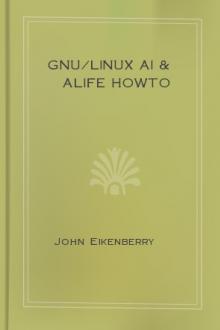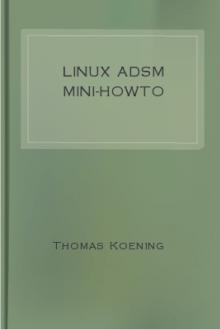GNU/Linux AI & Alife HOWTO, John Eikenberry [best books to read for self development TXT] 📗

- Author: John Eikenberry
- Performer: -
Book online «GNU/Linux AI & Alife HOWTO, John Eikenberry [best books to read for self development TXT] 📗». Author John Eikenberry
TclRobots, you must write a Tcl program that controls a robot.
The robot’s mission is to survive a battle with other robots.
Two, three, or four robots compete during a battle, each running
different programs (or possibly the same program in different
robots.) Each robot is equipped with a scanner, cannon, drive
mechanism. A single match continues until one robot is left
running. Robots may compete individually, or combine in a team
oriented battle. A tournament can be run with any number of
robot programs, each robot playing every other in a round-robin
fashion, one-on-one. A battle simulator is available to help
debug robot programs.
The TclRobots program provides a physical environment, imposing
certain game parameters to which all robots must adhere.
TclRobots also provides a view on a battle, and a controlling
user interface. TclRobots requirements: a wish interpreter
built from Tcl 7.4 and Tk 4.0.
TKQML
� Web site: www.csee.umbc.edu/tkqml/
TKQML is a KQML application/addition to Tcl/Tk, which allows Tcl
based systems to communicate easily with a powerful agent
communication language.
The Tocoma Project
� Web site: www.tacoma.cs.uit.no/
An agent is a process that may migrate through a computer
network in order to satisfy requests made by clients. Agents are
an attractive way to describe network-wide computations.
The TACOMA project focuses on operating system support for
agents and how agents can be used to solve problems
traditionally addressed by operating systems. We have
implemented a series of prototype systems to support agents.
TACOMA Version 1.2 is based on UNIX and TCP. The system supports
agents written in C, Tcl/Tk, Perl, Python, and Scheme (Elk). It
is implemented in C. This TACOMA version has been in public
domain since April 1996.
We are currently focusing on heterogeneity, fault-tolerance,
security and management issues. Also, several TACOMA
applications are under construction. We implemented StormCast
4.0, a wide-area network weather monitoring system accessible
over the internet, using TACOMA and Java. We are now in the
process of evaluating this application, and plan to build a new
StormCast version to be completed by June 1997.
UMPRS Agent
� Web site: http://www.marcush.net/IRS/
UMPRS supports top-down, goal-based reasoning and selects goals
and plans based on maximal priority. Execution of multiple
simultaneous goals are supported, with suspension and resumption
capabilities for each goal (i.e., intention) thread. UMPRS plans
have an integrated precondition/runtime attribute that constrain
their applicability. Available plan constructs include:
sequencing, iteration, subgoaling, atomic (i.e., non-interruptable) blocks, n-branch deterministic conditional
execution, explicit failure-handling section, and C++ primitive
function definition.
Virtual Secretary Project (ViSe)
(Tcl/Tk)
� Web site: www.vise.cs.uit.no/vise/
The motivation of the Virtual Secretary project is to construct
user-model-based intelligent software agents, which could in
most cases replace human for secretarial tasks, based on modern
mobile computing and computer network. The project includes two
different phases: the first phase (ViSe1) focuses on information
filtering and process migration, its goal is to create a secure
environment for software agents using the concept of user
models; the second phase (ViSe2) concentrates on agents’
intelligent and efficient cooperation in a distributed
environment, its goal is to construct cooperative agents for
achieving high intelligence. (Implemented in Tcl/TclX/Tix/Tk)
VWORLD
� Web site: zhar.net/projects/vworld/
Vworld is a simulated environment for research with autonomous
agents written in prolog. It is currently in something of an
beta stage. It works well with SWI-prolog, but should work with
Quitnus-prolog with only a few changes. It is being designed to
serve as an educational tool for class projects dealing with
prolog and autonomous agents. It comes with three demo worlds or
environments, along with sample agents for them. There are two
versions now. One written for SWI-prolog and one written for
LPA-prolog. Documentation is roughly done (with a
student/professor framework in mind), and a graphical interface
is planned.
WebMate
� Web site: www.cs.cmu.edu/~softagents/webmate/
WebMate is a personal agent for World-Wide Web browsing and
searching. It accompanies you when you travel on the internet
and provides you what you want.
Features include:
� Searching enhancement, including parallel search, searching
keywords refinement using our relevant keywords extraction
technology, relevant feedback, etc.
� Browsing assistant, including learning your current
interesting, recommending you new URLs according to your
profile and selected resources, monitoring bookmarks of
Netscape or IE, sending the current browsing page to your
friends, etc.
� Offline browsing, including downloading the following pages
from the current page for offline browsing.
� Filtering HTTP header, including recording http header and
all the transactions between your browser and WWW servers,
etc.
� Checking the HTML page to find the errors or dead links,
etc.
� Programming in Java, independent of operating system, runing
in multithread.
Yampa
� Web site: http://www.haskell.org/yampa/
FRP system with robotics library and graphical interactive
robotics simulator.
Functional reactive programming, or FRP, is a paradigm for
programming hybrid systems �i.e., systems containing a
combination of both continuous and discrete components �in a
high-level, declarative way. The key ideas in FRP are its
notions of continuous, time-varying values, and time-ordered
sequences of discrete events. Yampa is an instantiation of FRP
as a domain-specific language embedded in Haskell.
Zeus
� Web site: more.btexact.com/projects/agents/zeus/
The construction of multiagent systems involves long
development times and requires solutions to some considerable
technical difficulties. This has motivated the development of
the ZEUS toolkit, which provides a library of software
components and tools that facilitate the rapid design,
development and deployment of agent system
7. Programming languagesWhile any programming language can be used for artificial
intelligence/life research, these are programming languages which are
used extensively for, if not specifically made for, artificial
intelligence programming.
Allegro CL
� Web site: www.franz.com
Franz Inc’s free linux version of their lisp development
environment. You can download it or they will mail you a CD free
(you don’t even have to pay for shipping). It is generally
considered to be one of the better lisp platforms.
APRIL
� Web site: sourceforge.net/projects/networkagent/
APRIL is a symbolic programming language that is designed for
writing mobile, distributed and agent-based systems especially
in an Internet environment. It has advanced features such as a
macro sublanguage, asynchronous message sending and receiving,
code mobility, pattern matching, higher-order functions and
strong typing. The language is compiled to bytecode which is
then interpreted by the APRIL runtime-engine. APRIL now
requires the InterAgent Communications Model (ICM) to be
installed before it can be installed. [Ed. ICM can be found at
the same web site]
Ciao Prolog
� Web site: www.clip.dia.fi.upm.es/Software/Ciao/
Ciao is a complete Prolog system subsuming ISO-Prolog with a
novel modular design which allows both restricting and extending
the language. Ciao extensions currently include feature terms
(records), higher-order, functions, constraints, objects,
persistent predicates, a good base for distributed execution
(agents), and concurrency. Libraries also support WWW
programming, sockets, and external interfaces (C, Java, TCL/Tk,
relational databases, etc.). An Emacs-based environment, a
stand-alone compiler, and a toplevel shell are also provided.
DHARMI
� Web site: http://megazone.bigpanda.com/~wolf/DHARMI/
DHARMI is a high level spatial, tinker-toy like language who’s
components are transparently administered by a background
process called the Habitat. As the name suggests, the language
was designed to make modelling prototypes and handle living
data. Programs can be modified while running. This is
accomplished by blurring the distinction between source code,
program, and data.
ECLiPSe
� Web site: eclipse.crosscoreop.com/eclipse/
ECLiPSe is a software system for the cost-effective development
and deployment of constraint programming applications, e.g. in
the areas of planning, scheduling, resource allocation,
timetabling, transport etc. It is also ideal for teaching most
aspects of combinatorial problem solving, e.g. problem
modelling, constraint programming, mathematical programming, and
search techniques. It contains several constraint solver
libraries, a high-level modelling and control language,
interfaces to third-party solvers, an integrated development
environment and interfaces for embedding into host environments.
ECoLisp
� Web site (???): www.di.unipi.it/~attardi/software.html
ECoLisp (Embeddable Common Lisp) is an implementation of Common
Lisp designed for being embeddable into C based applications.
ECL uses standard C calling conventions for Lisp compiled
functions, which allows C programs to easily call Lisp functions
and viceversa. No foreign function interface is required: data
can be exchanged between C and Lisp with no need for conversion.
ECL is based on a Common Runtime Support (CRS) which provides
basic facilities for memory managment, dynamic loading and
dumping of binary images, support for multiple threads of
execution. The CRS is built into a library that can be linked
with the code of the application. ECL is modular: main modules
are the program development tools (top level, debugger, trace,
stepper), the compiler, and CLOS. A native implementation of
CLOS is available in ECL: one can configure ECL with or without
CLOS. A runtime version of ECL can be built with just the
modules which are required by the application. The ECL compiler
compiles from Lisp to C, and then invokes the GCC compiler to
produce binaries.
ESTEREL
� Web site: www-sop.inria.fr/meije/esterel/
Esterel is both a programming language, dedicated to programming
reactive systems, and a compiler which translates Esterel
programs into finite-state machines. It is particularly well-suited to programming reactive systems, including realtime
systems and control automata.
Only the binary is available for the language compiler. :P
G�el
� Web page: www.cs.bris.ac.uk/~bowers/goedel.html
G�el is a declarative, general-purpose programming language in
the family of logic programming languages. It is a strongly
typed language, the type system being based on many-sorted logic
with parametric polymorphism. It has a module system. G�el
supports infinite precision integers, infinite precision
rationals, and also floating-point numbers. It can solve
constraints over finite domains of integers and also linear
rational constraints. It supports processing of finite sets. It
also has a flexible computation rule and a pruning operator
which generalizes the commit of the concurrent logic programming
languages. Considerable emphasis is placed on G�el’s meta-logical facilities which provide significant support for meta-programs that do analysis, transformation, compilation,
verification, debugging, and so on.
CLisp (Lisp)
� Web page: clisp.sourceforge.net
� Alt Web site: clisp.cons.org
CLISP is a Common Lisp implementation by Bruno Haible and
Michael Stoll. It mostly supports the Lisp described by Common
LISP: The Language (2nd edition) and the ANSI Common Lisp
standard. CLISP includes an interpreter, a byte-compiler, a
large subset of CLOS (Object-Oriented Lisp) , a foreign language
interface and, for some machines, a screen editor.
The user interface language (English, German, French) is chosen
at run time. Major packages that run in CLISP include CLX &
Garnet. CLISP needs only 2 MB of memory.
CMU Common Lisp
� Web page: www.cons.org/cmucl/
� Linux Installation: www.telent.net/lisp/howto.html
CMU Common Lisp is a public domain “industrial strength” Common
Lisp programming environment. Many of the X3j13 changes have
been incorporated into CMU CL. Wherever possible, this has been
done so as to transparently allow the use of either CLtL1 or
proposed ANSI CL. Probably the new features most interesting to
users are SETF functions, LOOP and the WITH-COMPILATION-UNIT
macro.
GCL (Lisp)
� FTP site: ftp.ma.utexas.edu/pub/gcl/
GNU Common Lisp (GCL) has a compiler and interpreter for Common
Lisp. It used to be known as Kyoto Common Lisp. It is very
portable and extremely efficient on a wide class of
applications. It compares favorably in performance with
commercial Lisps on several large theorem-prover and symbolic
algebra systems. It supports the CLtL1 specification but is
moving towards the proposed ANSI definition. GCL compiles to C
and then uses the native optimizing C compilers (e.g., GCC). A
function with a fixed number of args and one value turns into a
C function of the same number of args, returning





Comments (0)